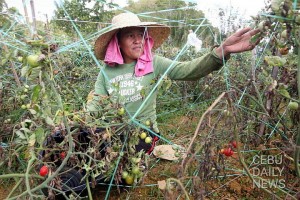
A farmer harvests tomatoes from her farm in an upland barangay in Cebu City. (CDN FILE PHOTO)
Residents of Cebu City’s upland barangays were told to procure containers and hoses to ration water from mobile water siphon tanks provided by the Metropolitan Cebu Water District (MCWD).
“The MSTs operate 24 hours a day. What will happen to the potable water that will be produced? Where will we store those?” MCWD board chairman Rene Mercado told reporters.
Two weeks ago, MCWD sent two mobile siphon tanks to the rivers of barangays Bonbon and Cambinocot.
READ: State of calamity for 31 upland barangays
The equipment was donated by the Japan International Cooperation Agency (Jica) and invented by Nihon Genryo Co. Ltd of Japan.
The MST in Cambinocot can produce seven cubic meters per hour but at Bonbon, the tanks can produce 20 cubic meters of water per hour.
A submersible pump is placed in the river to draw the water and place it in big plastic tanks.
Raw water is then treated with poly-aluminum chloride to remove turbidity and liquid chlorine or sodium hypochlorite through an electric pump.
Beyond December
The water then goes into a tank’s filter which has four faucets that residents open to fill their containers with purified water.
Mercado said the water they sourced from the bulk water supply project in Carmen town, northern Cebu increased to 6,000 cubic meters a day, raising their supply to 24,000 cubic meters from 18,000 cubic meters.
MCWD general manager Ernie Delco said the increased water supply stems from the additional 10,000 new consumers serviced by the district.
The water supply from the Jaclupan dam in Talisay City went down from 33,000 cubic meters daily to 11,000 cubic meters while the water supply in barangay Buhisan, Cebu City dwindled from 10,000 cubic meters to 2,000 cubic meters.
READ: CEBU IN TOP 12 El NIÑO ZONES
Delco said while the water supply is within manageable levels, he’s concerned that the dry spell will last beyond December.
He said barangays Sambag I, Sambag II, Banawa and Pardo in Cebu City are affected while barangays Lagtang, Lawa-an and Pooc in Talisay City experience low water supply.
“The reason is that portions of these areas are elevated. What we are doing right now is we use water pressure tanks to pump the water,” Delco said.
He advised residents to use containers to store rainwater at the start of the rainy season next month.
Usual reminder
Cebu City Councilor David Tumulak, who heads the quick response team of the Disaster Risk Reduction Management Council (DRRMC), said he will meet with farmers to discuss the extent of the damage caused by the dry spell.
Cebu City Mayor Michael Rama said he is thankful to the city council for approving his declaration placing 31 upland barangays under calamity status.
“I would like to thank the council’s sensitivity. Even if it’s a little bit late, still it’s better to be late than never,” Rama told reporters during yesterday’s press conference at the Taboan public market.
He said the challenge now lies with the barangays, the Hillyland Commission and the DRRMC’s quick response team to prepare a plan to help the mountain barangays affected by the water shortage.
The council also requested the executive department to undertake a comprehensive study to further address the El Niño problem.
“My usual reminder to the council before was, ‘Are we planning for El Niño?’ That plan will always be there. Remember that El Niño is the new normal so we have to look into that,” Rama said.
Rama mentioned the Metropolitan Cebu Water District’s (MCWD) mobile siphon filters, barrels, tanks, reservoirs and identification of springs, as among the interventions needed to resolve the water shortage.
Cash aid and technical assistance will be extended to the 31 barangays to enable them to cope with the declining water supply./With Xavier University Interns Pearl Therese S. Aton and Ana Liza Jane Banaynal